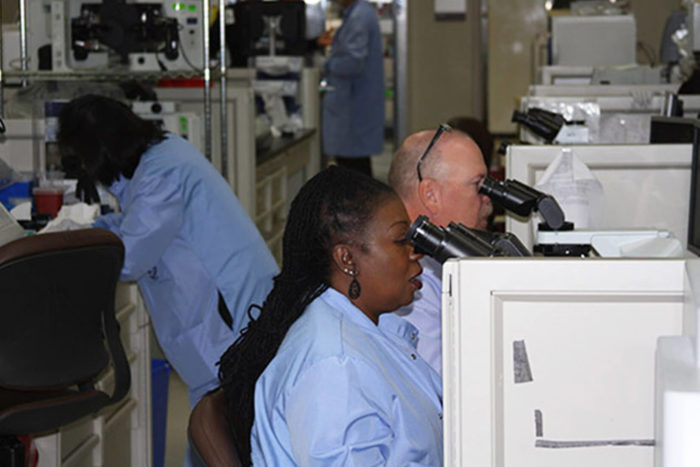
Navy photo by Lt. J.G. Fae DeForrest)
BETHESDA, MD—With a long history of point of care testing at both of its predecessor organizations, the Walter Reed National Military Medical Center (WRNMMC) laboratory services staff were keenly aware of the advantages of using portable testing devices to obtain rapid patient assessments. They were also painfully aware of the time involved in manually entering point-of-care testing data into the Composite Health Care System (CHCS), which is both the laboratory information system (LIS) used by all DoD medical treatment facilities and the foundation of the Armed Forces Health Longitudinal Technology Application (AHLTA), the DoD’s electronic health record.
When the National Naval Medical Center and Walter Reed Army Medical Center merged, both already had point-of-care testing (POCT) programs in place and their own procedures for ensuring results were recorded in the patient record. The combined organization continued to expand its use of POCT, ultimately involving 1,300 active POCT users employing 27 different assays at 42 sites, according to a presentation at a Clinical Laboratory Management Association conference by members of the WRNMMC laboratory services staff.
POCT offers several advantages, explaining its widespread use in a medical center with industry-leading laboratory services. Notably, POCT offers speed of results and low sample volume. ‘The clinicians can have an answer within a few minutes, and many times the sample is only a finger stick vs. a tube of blood,” said lead author of the presentation Samuel Erickson, MS, chief of laboratory services at the Kimbrough Ambulatory Care Center at Fort Meade, Maryland, and former deputy laboratory manager at WRNMMC.
However, there also were issues associated with high levels of use. ‘Due to the labor-intensive process, quantity of results, and non-laboratory-trained staff, managing the [POCT] results was a herculean effort,” the authors wrote.
The manual entry of results created the greatest challenges, according to Erickson. ‘Patient safety was the main concern because the POCT assays performed did not always make it into the patient’s medical record. This was concerning, because that snapshot in time of how the patient was doing was lost, and clinicians wouldn’t have a record to look at the trends in the patient’s condition,” he said.
‘Also, because the process involved a person manually transcribing the results from the analyzer to the medical record, clerical errors would happen,” Erickson explained. ‘Automating the process removed the human element and made clerical errors obsolete,” he told U.S. Medicine.
To streamline the process, WRNMMC partnered with Alere Informatics to implement a data management system that automatically linked the point of care devices with the CHCS. The new system dramatically increased efficiency, saving 6,000 hours of employee time in 2017. Before the devices and electronic records were connected, testing and uploading results involved a nine-step manual process. Now, only three steps are required. Previously, a physician would order a POC test, which a staff member would perform. He or she would then log into CHCS, find the patient, order the test, manually copy results from the device to CHCS, verify the results were copied correctly, certify the results and, finally, dock the device on the uploader. In the new process, the clinician orders a POCT, a staff member performs it and then docks the device on the uploader. Done.
Erickson said manual assays such as urine HCG and rapid strep are also automated by using the analyzer to document the results. The manual test will be performed, and then the POCT user will identify the patient in the analyzer, select the test and test result; then the test results are automatically entered into the patient’s medical record.
In addition to saving thousands of hours, automation also increases compliance with test result reporting requirements. The authors found that result entry compliance rose from 97% before implementation of the new system to 100% afterward, an increased reporting of more than 3,000 test results each year. As a result, clinicians have a better picture of their patients’ status and a more reliable basis for making treatment decisions.
The automation of the process was seen as a critical step in making WRNMMC a high-reliability organization and center of excellence, said Erickson, and the point of care team is diligently working to bring all the POC assays and sites into the new system.
The automated system is now used throughout WRNMMC, including intensive care units, emergency department, outpatient pediatrics, pediatric subspecialty units, nephrology, gastrointestinal clinic, pulmonary, anticoagulation clinic, internal medicine and the National Intrepid Center of Excellence, as well as inpatient floors. Erickson noted that the inpatient floors have seen the greatest time savings; because they ‘perform the most POCT assays, they gain the most from the automation.”
